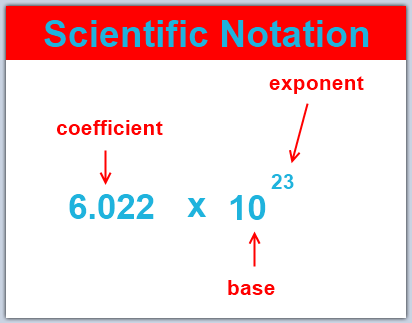Scientific Notation
– Exponents are used to write very large and very small positive numbers in scientific notation. Scientific notation has two factors and follows the format a x 10n

The first factor, known as the coefficient, has to be a number that is greater than 1, and less than 10.
The second factor is a base of 10 raised to any power. The power depends on how many decimal places have been jumped.
- The standard form of a number is writing the number out in its entirety. Ex: 6.02 x 103 is equal to 6020.
- All you are simply doing when multiplying by a base of 10 is moving the decimal point according to the exponent.
Squares & Square Roots
– a2 = squaring
*If a2 = b, then a is called the square root of b

*PERFECT SQUARES are called “perfect”, because they have whole numbers as square roots. To find the square root of a number, think about which factor when multiplied by itself will give you that square. Ex: √64 = 8 because 8² = 64
*When finding the square root of a nonperfect square, you can approximate between two numbers. Ex: √28 – this is between √25 and √36, so your answer is between 5 and 6.
To find the LCM of two or more numbers:
- Find the prime factorization of each number.
- Take the highest valued numbers from each factorized number and multiply them.
*If there are multiple copies of the highest valued number for a factorized number, include only the copy that has the highest exponent.